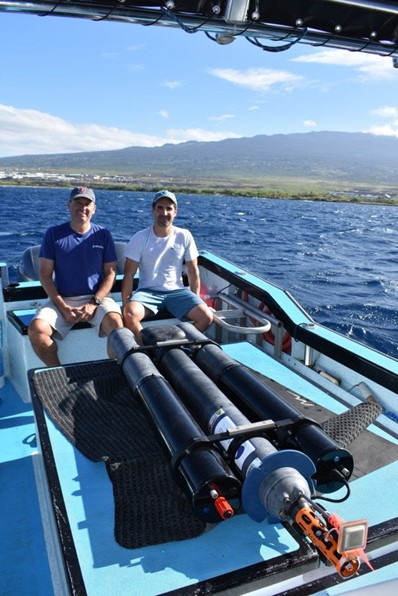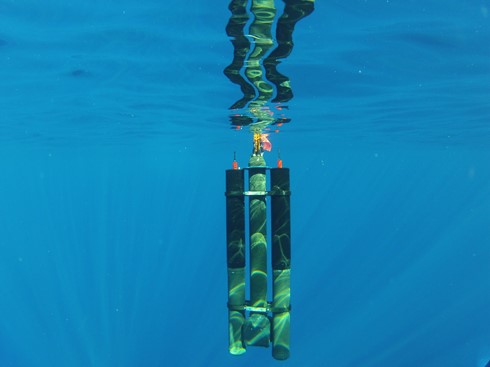Motivated by a passion for the discovery and exploration of our oceans, oceanographer Yi Chao is on a mission to harness and create sustainable energy for current and future generations. How? Underwater robots.
“Our plan is to power tens of thousands of autonomous robots underwater to collect essential environmental data to protect our oceans and make better economic decisions,” said Chao, Founder and CEO of Seatrec. “We also plan to deploy the first underwater charging stations for these robots.”
Chao and his small team of engineers and scientists recently relocated to Vista from Los Angeles in hopes of not only expanding Seatrec’s technology and footprint, but to also take advantage of the region’s building wave of bluetech companies. We recently caught up with Chao, who took a deep dive into Seatrec’s fascinating technology, along with why being in Vista makes sense for his startup to flourish.
From Seasickness to Success: Nearly three decades ago, Chao set sail so-to-speak on his first oceanographic cruise on a vessel off the coast of Monterey, Calif. At the time, he was a research scientist for NASA’s famous Jet Propulsion Lab (JPL). The goal of that first mission was to measure sea surface salinity to validate the measurements made by his NASA coworkers on a C-140 aircraft. Sadly, however, this was his first and last voyage out to sea due to seasickness (which he still suffers from today).
But, it was not the end of his oceanography career. He decided to focus on computational oceanography, developing computer models to simulate the ocean; and satellite oceanography, launching the first NASA salinity satellite.
“Satellites can only measure the ocean surface. To measure deep into the ocean, we need a fleet of underwater robots,” Chao marveled.
Developing a renewable energy solution to power these robots motivated him to develop the technology at NASA JPL and later on establish his own startup, Seatrec, for commercialization.
Chao formed a team of engineers at NASA JPL to develop the core technology and then the team launched our first commercial product.
“I was inspired by the oceanographic pioneer Henry Stommel, who envisioned a network of floats powered by the sea,” he said. “Stommel inspired an entire generation of oceanographers to find a method to provide subsurface ocean data on a scale and frequency similar to what weather balloons did for the earth’s atmosphere. The bottleneck for this scale of ocean observation has always been power. Seatrec’s mission is to continue the quest by generating power from the infinite source of renewable thermal energy in the ocean.”
How it Works: Seatrec’s energy harvesting technology works by using phase change materials (PCMs) to convert the energy associated with the naturally occurring temperature differential in the ocean into electricity. Seatrec designs and manufactures energy harvesting solutions to power underwater drones to extend mission life and optimize data capture in the most eco-friendly manner possible.
In 2020, Seatrec took the top award in the Department of Energy’s Powering the Blue Economy Ocean Observing Prize for its revolutionary work in creating a green energy solution for persistent ocean observation to power profiling floats and underwater gliders. Competitors were asked to submit novel concepts and ideas to integrate ocean observing sensors and platforms with marine energy systems.
Sea Solutions: Seatrec is also seeking other applications for its technology.
“Several areas would benefit tremendously from a clean power solution,” Chao said. “Seatrec is developing an underwater charging station for drones in collaboration with Northrop Grumman. Additionally, we’re currently exploring applications in aquaculture – offshore seaweed farming, optimizing shipping routes, and predicting hurricanes.

Recovery operation
Dr. David Fratantoni (left) and Michael Zedelmair (right) of Seatrec after the successful deployment and recovery operation. (Photo: Cole Arrington)
Sea Bots: By the end of the decade, Seatrec’s goal is to map the gaps in its current world seafloor measurements.
“Seatrec’s technology will power robots, drones, and sensors measuring subsurface ocean data with the energy extracted from the ocean’s infinite source of thermal energy. As we often say, by the ocean, for the ocean,” Chao said.
Eco Sensors: Most renewable energy sources are at the ocean surface, including solar, wind, and wave. Seatrec is the only subsurface solution, Chao said. Today’s underwater sensors mostly rely on batteries that have a limited lifetime and fall to the bottom of the ocean, creating potentially harmful environmental issues. Seatrec’s technology, he said, provides an eco-friendly way to extend the sensor life indefinitely and dramatically reduce the cost of data collection underwater.
“There is significant potential to apply Seatrec’s technology to seaweed farming offshore to use multiple renewable energy sources instead of diesel energy to produce healthy food and clean biofuel, and remove carbon dioxide from the atmosphere to combat climate change,” he said.

Seatrec’s Twins SL1s technology.
Partners: Seatrec is currently working with academic institutions, such as Rutgers University; government agencies including NOAA, the DoD/Navy, and Defense Advanced Research Projects Agency (DARPA); philanthropic organizations such as Schmidt Family Foundation; and industry giants like Northrop Grumman to further expand its technology.
Company Growth: Chao started Seatrec as the sole founder, and now the startup has eight employees and half a dozen contracting consultants. Currently, Seatrec has three full-time positions open for electrical, mechanical, and product engineers in its new 4,000 square-foot facility in the Vista Business Park. The facility includes open warehouse space, a 16-foot ceiling to fit and hoist water tanks, a rolling door, and a loading dock.
“We are incredibly excited about our move into Vista,” Chao said. “We very much look forward to exploring greater San Diego County and collaborating with the community, city, local representatives to make Vista a world-class hub for bluetech and grow the ‘Blue Economy.’”
Sea Change: Chao said San Diego County is the place to be for bluetech.
“First, San Diego has world-class research facilities (Scripps Institution of Oceanography, UCSD) with talent in the blue tech space. Second, it’s also home to many leading defense contractors, including Northup Grumman. Third, San Diego is a burgeoning cluster of bluetech companies with a well-established supply chain and manufacturing capabilities,” he said.
“Having Congressman Mike Levin as a champion of ocean-related issues is also a big plus. We believe it will be critical to unite public and private goals to significantly impact the local bluetech industry,” he added.
Chao was first introduced to the region through TMA Blue Tech, and then, with the help of the San Diego North Economic Development Council (SDNEDC), he discovered Vista and was introduced to Congressman Mike Levin.
“Seatrec has received a warm welcome from multiple people and organizations around the city of Vista,” he said.
For Vista, attracting a company like Seatrec will help position the city as a bluetech center.
“We are excited to welcome Yi and his team at Seatrec to our City,” said Vista Mayor Judy Ritter. “Attracting companies like Seatrec will help Vista further benefit from the ‘Blue Economy,’ including green and blue job creation and critical sustainable solutions for our region and beyond.”
North County Bluetech Hub: Seatrec is one of many bluetech companies that call North County home. In fact, Erik Bruvold, Executive Director of the SDNEDC, said North County is becoming a hub for this exciting industry.
“We see some companies in the energy space, underwater exploration, and gear space that are growing here,” Bruvold said “We’ve had long standing clusters in North County focused on filters and osmosis, and sewage treatment. Some of it was sparked by initial investments that Poseidon made for the desalination plant in Carlsbad.”
Bruvold added that the SDNEDC has had recent interest from about half a dozen blue tech companies in a variety of spaces who are considering setting up shop in North County.
“One key thing they are leveraging is talent. Locating in North County provides them a little bit of a larger talent pool to pull from and the commutes are not as bad. They are able to pull talent from San Diego and Orange County. Our rents in North County are also 10-to-15% cheaper comparable to areas like Sorrento Mesa.”
Bruvold believes that having a company like Seareec in Vista will attract more like-minded companies to North County.
“We are really excited about Yi and his leadership and willingness to talk about ocean technology and how it can create opportunities for greater sustainability and greater scientific research, as well as help create a critical mass of companies here,” he said.
San Diego’s Blue Economy: San Diego County is currently home to more than 200 bluetech companies, both large and small, according to TMA BlueTech, a local nonprofit that promotes the sustainable science-based ocean and water industries. The region’s bluetech cluster is a sub-sector of the larger, broader local “Blue Economy,” which accounts for more than 1,400 companies, supporting 46,000 jobs, and generating $14 billion in direct sales. Jobs in this industry – made up of innovative ocean and water-related products and services, renowned academic institutions, an enormous Navy presence, and technologies that range from small sensors to sophisticated maritime robotics – include mechanical engineers, engineering techs, and drafters.
Some of the sectors TMA BlueTech focuses on are aquaculture and fishing technology; biomarine; desalination and water/wastewater tech; large floating platforms; marine recreation (the tech portion); marine renewable energy; maritime robotics (platforms and sensors); ocean observation; and weather and climate change.
TMA BlueTech also provides mentorship and facility space for startups through its BlueTech Incubator.
“Seatrec is a very innovative bluetech company that will definitely add to the growing, regional community,” said Michael B. Jones, TMA BlueTech’s President. “Its technology will allow it to work with a number of existing TMA member companies and others globally.”
Jones said North County has a growing number of blue tech companies, particularly strong in water/wastewater technologies and growing in ocean tech. “It is an exciting field with great opportunities to create good-paying blue jobs,” he said, adding that bluetech is critical to understanding the ocean and limited water resources. “It is critical to come up with solutions to problems that have developed over hundreds, even thousands of years.”
Going with the Flow: While he’s excited to be part of helping to fuel the region’s bluetech sector, Chao couldn’t envision doing anything else.
“I love the discovery and exploration of our oceans, the last frontier on Earth,” he said. “I also enjoy the constant challenges of running a deep tech startup company. Raising private capital during COVID-19 was also a challenging, but unique learning experience. I am constantly learning and always happy to see the growth of the team and company. Doing a startup after two decades working for the government has been the highlight of my career.”



















